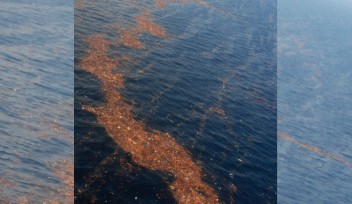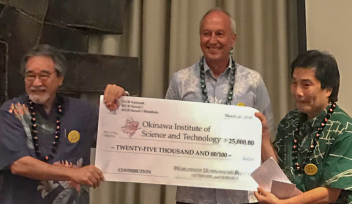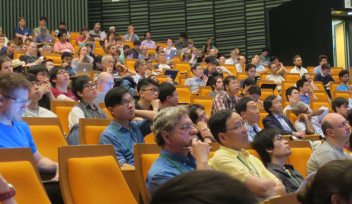Intimate symposia format strengthens OIST research collaborations

Okinawa Institute of Science and Technology Graduate University (OIST) is hosting a variety of mini-symposia this year, a new workshop format designed to foster international exchange about current research advances.
The 2-day or 3-day meetings include about 10 experts from around the world to discuss specific topics such as ancient DNA, quantum control of light and matter, and advanced cancer therapy instrumentation. All invited participants and OIST organizers present their work during the symposium, sharing different perspectives in technical talks.
Mini-symposia are set up within six months, rather than the two years it typically takes to organize major OIST workshops that last up to three weeks. This enables scientists to discuss recent advances or current challenges in their field.
“It gives us a chance to talk about what we are doing right now, not what we did two years ago,” said Prof. Erik De Schutter, who runs the Computational Neuroscience Unit and recently hosted a mini-symposium “Recent Findings on the Cerebellar Microcircuitry.”
The intimate gatherings are a unique opportunity to get to know other scientists over several days, said Prof. Alexander Mikheyev of the OIST Ecology and Evolution Unit, who recently organized “Ancient DNA Symposium: New tools for archaeological samples.”
“It’s a different dynamic that allows you to have more in-depth discussions,” he said.
Even with the ease of international communication provided by teleconferences and email, face-to-face interaction remains invaluable.
“When you are talking about theoretical physics, it’s a bit painful writing out equations in email,” said Prof. Síle Nic Chormaic, who heads the Light-Matter Interactions Unit and hosted a symposium “Quantum Control of Light and Matter” with collaborators from the Japanese Society for the Promotion of Science. “It’s idea sharing in a quicker environment.”
In some cases, participants know each other, but often, they are meeting for the first time.
“I thought there was an interesting group of people they put together,” said Morten Rasmussen from the Natural History Museum of Denmark and Stanford University, who attended the ancient DNA symposium. “Some of the names I know obviously, but some I didn’t know exactly what they are doing. You hear names, but you don’t know the details of what they are doing.”
The meetings raise awareness about the relatively new university and the wide array of research conducted here. They also help strengthen ties and research collaborations with other organizations far from Okinawa.
“It helped people from mainland universities come here and see the OIST environment and how open we are,” Nic Chormaic said. “It encourages them to collaborate with us.”
At least 10 mini-symposia will take place this year. For a complete list, please click here.
“We created this series as a catalyst for excellent people to meet each other and exchange ideas,” said Youhei Morita, associate vice president of Communication and Public Relations who manages OIST conferences and workshops. “We are pleased to have established this program and look forward to many more mini-symposia in the future.”
For press enquiries:
Press Inquiry Form
















